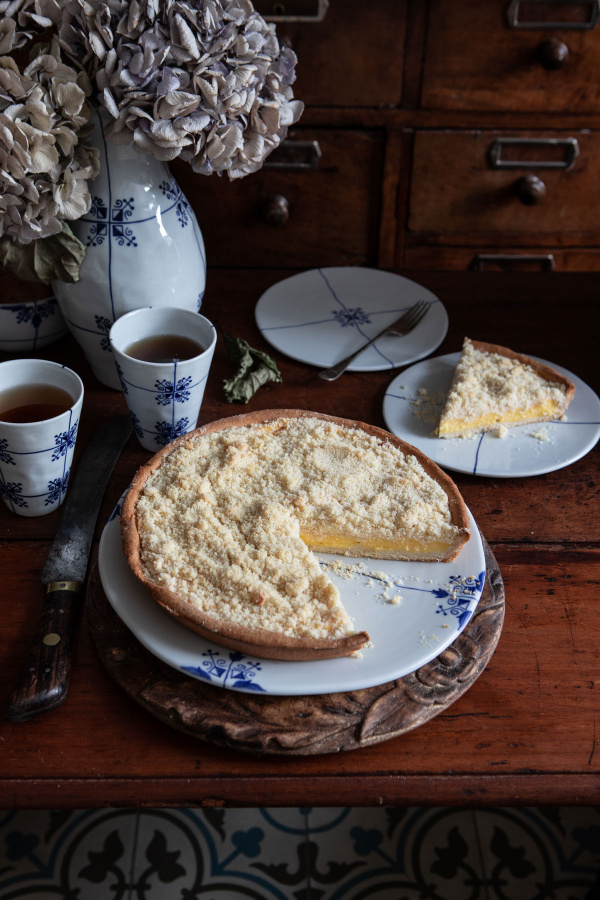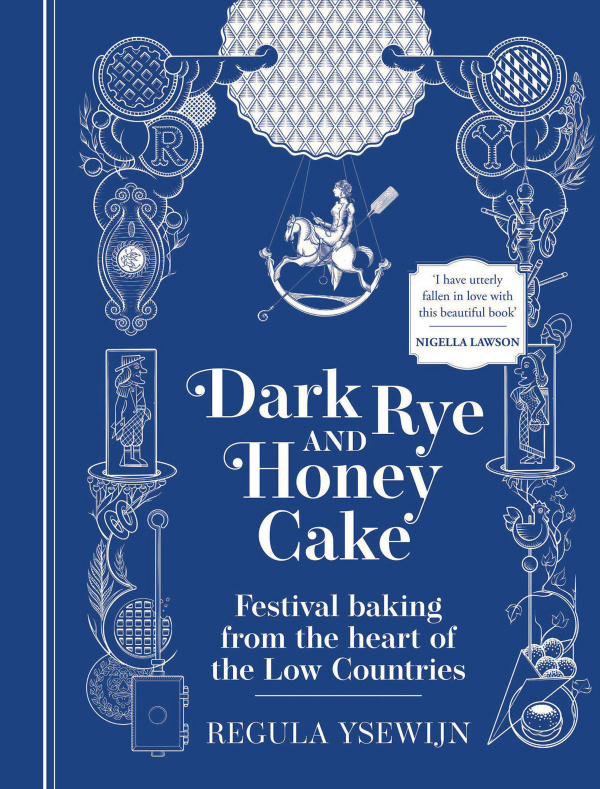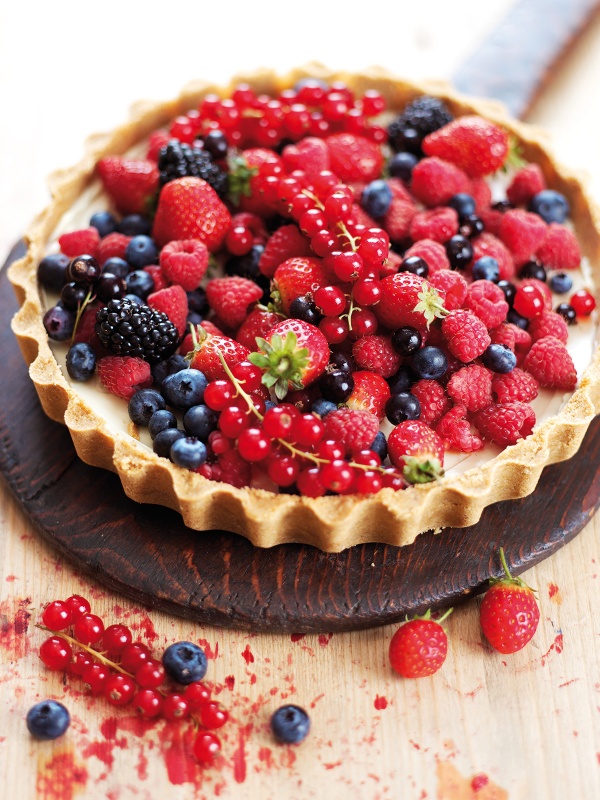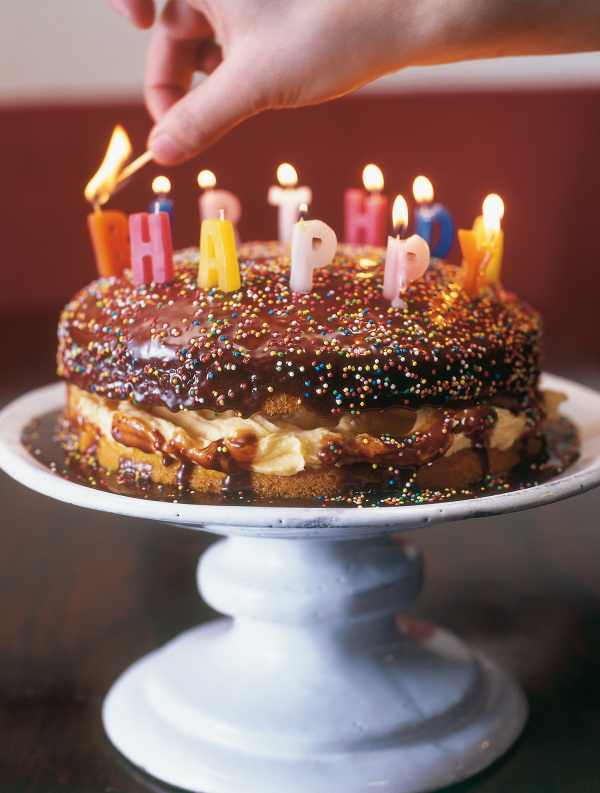Potsuikervlaai
by Regula Ysewijn, featured in Dark Rye and Honey Cake Published by Murdoch BooksIntroduction
This sugar and custard tart has an excellent velvet-like mouthfeel with the sandy sugar topping as a contrast. One of our contestants on Bake Off in Flanders was from the Flemish Limburg region, where vlaai are most popular today. Four years later I found myself by chance in the bakery where she buys her favourite vlaai and I talked to the baker. After I tasted it, it is now a firm favourite in our house too.
The potsuiker in the name translates to ‘bowl of sugar’, which is rather interesting as potsuyckere was used as the name for sugar scraped from solid sugar loaves (cones) in 15th-century cookery texts. In Een notabel boecxken van cokeryen, the first printed cookery book in Dutch, I found saenvladen, a flan-like custard tart (without a crust) sweetened with potsuyckere. The recipe right before it in the same book is gouwieren, a cheese and egg bake — it’s unclear if it has a crust or not — topped with egg yolks and sugar. After it is baked, potsuyckere is added on top. Maybe a reader thought adding sugar on top of a baked pie was a good idea from reading the first recipe and added it to the second. The flan got a crust, the sugar was mixed with some butter and flour ét voila, you have a potsuikervlaai. Could it be this easy? Sometimes it is, but we cannot say for sure. What is sure, is that this vlaai does not appear in 17th, 18th or 19th-century cookbooks.
This sugar and custard tart has an excellent velvet-like mouthfeel with the sandy sugar topping as a contrast. One of our contestants on Bake Off in Flanders was from the Flemish Limburg region, where vlaai are most popular today. Four years later I found myself by chance in the bakery where she buys her favourite vlaai and I talked to the baker. After I tasted it, it is now a firm favourite in our house too.
The potsuiker in the name translates to ‘bowl of sugar’, which is rather interesting as potsuyckere was used as the name for sugar scraped from solid sugar loaves (cones) in 15th-century cookery texts. In Een notabel boecxken van cokeryen, the first printed cookery book in Dutch, I found saenvladen, a flan-like custard tart (without a crust) sweetened with potsuyckere. The recipe right before it in the same book is gouwieren, a cheese and egg bake — it’s unclear if it has a crust or not — topped with egg yolks and sugar. After it is baked, potsuyckere is added on top. Maybe a reader thought adding sugar on top of a baked pie was a good idea from reading the first recipe and added it to the second. The flan got a crust, the sugar was mixed with some butter and flour ét voila, you have a potsuikervlaai. Could it be this easy? Sometimes it is, but we cannot say for sure. What is sure, is that this vlaai does not appear in 17th, 18th or 19th-century cookbooks.

Share or save this
Ingredients
Serves: 4-6
FOR THE PASTRY
- 250 grams strong bread flour
- 100 grams unsalted butter (softened)
- 25 grams caster sugar
- 7 grams instant or other active dry yeast
- ½ teaspoon salt
- 85 millilitres water
FOR THE CUSTARD
- 6 egg yolks
- 80 grams caster sugar
- 25 grams custard powder or cornflour (cornstarch)
- 450 millilitres full fat milk
- 50 millilitres double cream
- 1 vanilla bean (split) or 1 bay leaf
FOR THE SUGAR-CRUMB TOPPING
- 50 grams butter (softened)
- 90 grams plain flour
- 90 grams soft light brown sugar
FOR THE PASTRY
- 9 ounces strong bread flour
- 3½ ounces unsalted butter (softened)
- 1 ounce superfine sugar
- ¼ ounce instant or other active dry yeast
- ½ teaspoon salt
- 2¾ fluid ounces water
FOR THE CUSTARD
- 6 egg yolks
- 2¾ ounces superfine sugar
- 1 ounce custard powder or cornflour (cornstarch)
- 15½ fluid ounces whole milk
- 1¾ fluid ounces heavy cream
- 1 vanilla bean (split) or 1 bay leaf
FOR THE SUGAR-CRUMB TOPPING
- 1¾ ounces butter (softened)
- 3¼ ounces all-purpose flour
- 3¼ ounces soft light brown sugar
Method
Potsuikervlaai is a guest recipe by Regula Ysewijn so we are not able to answer questions regarding this recipe
Use a 27 cm (10¾ inch) top diameter x 23 cm (9 inch) base diameter x 3 cm (1¼ inch) depth pie tin, greased and floured.
- For the pastry, combine the flour, butter, sugar, yeast and salt in a large bowl or the bowl of an electric mixer fitted with the dough hook. Pour in the water and knead for 10 minutes until the dough is smooth. Cover the bowl and leave to rest for 1 hour or overnight in the fridge.
- For the sugar-crumb topping, rub the butter into the flour and sugar until the mixture is crumbly, then keep in the fridge until needed.
- Make the custard according to the instructions below.
- While the custard cools, preheat the oven to 180°C (350°F). Do not use the fan setting.
- When the pastry has risen, knock out the air and roll out the pastry as thin as you can, then lay it over the greased tin. Press it into the base and cut away the excess pastry. Pierce the base all over with a fork, then spoon the custard into the tart. Get the sugar crumb topping out of the fridge and sprinkle it over the custard.
- Bake in the middle of the oven for 30–35 minutes. Set aside to cool completely and serve cold.
FOR THE CUSTARD
- For the custard, have a large, shallow ovenproof dish ready. Whisk the egg yolks, sugar and custard powder until creamy. In French culinary terms, you’ve now made a ruban (ribbon).
- In a large saucepan, warm the milk and cream with the seeds of the vanilla bean. Remove from the heat and strain the milk if you want to get rid of the black vanilla seeds, or leave them in and show the world you used the real stuff. Add a tablespoon of the warm milk to the ruban and whisk well, then add the ruban to the warm milk, whisking constantly. Return the pan to the stove over low heat and whisk until the custard thickens, turning off the heat as soon as the mixture begins to give more resistance to whisking.
- Immediately pour the hot custard into the cold ovenproof dish, then cover the top of the custard (not the dish) with a sheet of plastic wrap. The plastic wrap prevents the custard from forming a skin. Let the custard cool.
Use a 27 cm (10¾ inch) top diameter x 23 cm (9 inch) base diameter x 3 cm (1¼ inch) depth pie tin, greased and floured.
- For the pastry, combine the flour, butter, sugar, yeast and salt in a large bowl or the bowl of an electric mixer fitted with the dough hook. Pour in the water and knead for 10 minutes until the dough is smooth. Cover the bowl and leave to rest for 1 hour or overnight in the fridge.
- For the sugar-crumb topping, rub the butter into the flour and sugar until the mixture is crumbly, then keep in the fridge until needed.
- Make the custard according to the instructions below.
- While the custard cools, preheat the oven to 180°C (350°F). Do not use the fan setting.
- When the pastry has risen, knock out the air and roll out the pastry as thin as you can, then lay it over the greased tin. Press it into the base and cut away the excess pastry. Pierce the base all over with a fork, then spoon the custard into the tart. Get the sugar crumb topping out of the fridge and sprinkle it over the custard.
- Bake in the middle of the oven for 30–35 minutes. Set aside to cool completely and serve cold.
FOR THE CUSTARD
- For the custard, have a large, shallow ovenproof dish ready. Whisk the egg yolks, sugar and custard powder until creamy. In French culinary terms, you’ve now made a ruban (ribbon).
- In a large saucepan, warm the milk and cream with the seeds of the vanilla bean. Remove from the heat and strain the milk if you want to get rid of the black vanilla seeds, or leave them in and show the world you used the real stuff. Add a tablespoon of the warm milk to the ruban and whisk well, then add the ruban to the warm milk, whisking constantly. Return the pan to the stove over low heat and whisk until the custard thickens, turning off the heat as soon as the mixture begins to give more resistance to whisking.
- Immediately pour the hot custard into the cold ovenproof dish, then cover the top of the custard (not the dish) with a sheet of plastic wrap. The plastic wrap prevents the custard from forming a skin. Let the custard cool.
Additional Information
A note on bay leaves:
Before vanilla took over our flavouring palate in the 19th century, bay was frequently used along with cinnamon to flavour custards. I adore bay leaf custard; why not give it a go?
A note on bay leaves:
Before vanilla took over our flavouring palate in the 19th century, bay was frequently used along with cinnamon to flavour custards. I adore bay leaf custard; why not give it a go?






Tell us what you think
Thank you {% member.data['first-name'] %}.
Explore more recipesYour comment has been submitted.